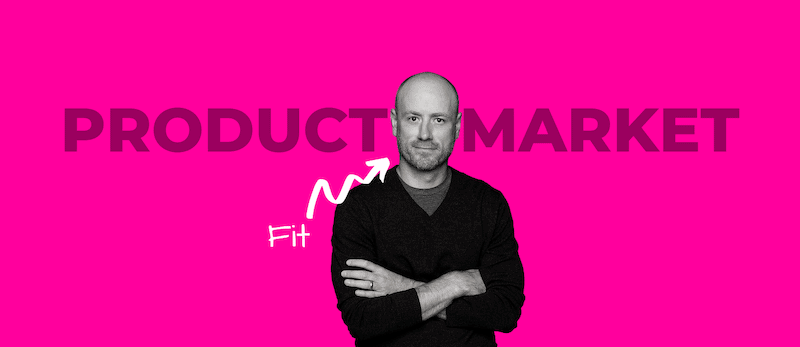
We have an eCommerce client enjoying 400% revenue growth this year. Facebook ads, email marketing, and conversion optimization played a part in that success, but these tactics are worthless without product-market fit. The thing that really moved the needle in this company’s success was cutting 80% of what they sell and refocusing the remaining 20% on the right buyers.
In other words, we convinced our client to sell 80% less product to a smaller group of people in order to grow revenue. Sounds counterintuitive, but it worked. And this wasn’t a random stroke of luck.
Sell a remarkable product to the right buyers and you’ll be successful. Your brand, website, and marketing will all fall into place if you get product-market fit right.
What is product-market fit?
Before we get into finding product-market fit, we need to talk about what it is. I’m going to bypass all of the jargon and fancy VC descriptions you’ll find elsewhere. Simply put, product-market fit means you’ve got a product that a specific group of buyers value, purchase, and tell their friends to buy. You know you don’t have product-market fit if you’re not getting repeat purchases, growth is slow, people aren’t using the product, word of mouth is non-existent, and you’re not converting prospects into buyers.
Don’t worry if you just read that last sentence and every point felt like a surgical blade slicing a different vein around your body. You always have the option of changing course. Like the eCommerce client mentioned above, you may be forced to shake things up. Sometimes that’s as easy as a little tweak to your product. Other times, you need to totally reinvent your company. This step-by-step guide will get you started down the path toward a product that spreads like wildfire with the right group of buyers.
Step 1: Sell painkillers or ecstasy, not vitamins.
Most companies think of a product, develop it, and then try to find a customer who will buy it. These companies will fail because they’re built on a faulty foundation. I see this with apparel brands, SaaS startups, and service businesses. No industry is immune to what I call the selfish product pitfall. It happens because we’re thinking about what we have to sell (or what we want to sell), not what someone is aching to buy.
The selfish product pitfall is kind of like selling vitamins. You develop a vitamin and then start trying to find ailments it may help. There’s no clear proof that your product fixes anything and nobody is busting down the doors to get their hands on your goods. Pushing a product that doesn’t solve a clear problem for a specific group of people is a tough way to make a living.
A more reliable approach is to start by defining a clear problem or desire a specific group of people have. Now figure out how to solve the problem or fulfill the desire. If you effectively do either, you’ll sell a ton of whatever you’re selling. This is true because every purchase happens for one of two reasons:
- Stop (or avoid) pain.
- Fulfill a desire.
Think of it like being a drug dealer. Are you going to sell painkillers or ecstasy? One makes pain go away, one fulfills a desire to feel fantastic. Both sell like crazy. I’m not advocating either dangerous drug, and I’m certainly not telling you to start selling addictive substances that ruin lives. This is simply the best example of what you want your product or service to be—highly desired and addictive.
People will beg, borrow, or rob their mama to get their hands on painkillers or ecstasy. There’s no need for a sales team in a drug cartel. It’s more of a logistics and distribution operation. There’s a reason they’re called drug dealers and not sellers.
But vitamins, they’re often part of multi-level marketing scams and aggressive advertising. They have to manufacture demand constantly. There’s no organic desire for the product.
I think you get the idea. Don’t pass go until you’ve found a specific group of people who will knock down your door if you give them a solution to a throbbing pain, or fulfill an aching desire.
Step 2: Pick a viable buyer.
Now it’s time to vet your buyer a bit before jumping in with both feet. Not everyone has the problem that your product solves. Others may want what you sell, but they’re not willing or able to pay for it. And then there are the people who have buckets of money and desire for the product, but trying to reach them is like finding a snow leopard in a blizzard.
These are all factors that must be considered when picking a viable buyer. We can break everything down into three criteria. Your ideal buyer must check all three of these boxes to be worth pursuing.
Buyer Criteria 1: They have a problem you can solve, or desire you fulfill.
I’m not going to pummel you with this topic further. Go back and read the first section of this article if you want more detail on solving a problem for a specific group of people. You can’t build a successful business without nailing this criteria.
Buyer Criteria 2: They’re willing (and able) to pay for a solution.
To once again revisit our example from above, I wouldn’t target drug addicts. They may have an overwhelming desire for what you sell, but they’re about as financially stable as a chair with one leg. It’s much easier to build a business on buyers who can afford what you sell. Focus your efforts on serving buyers with the desire and capability to pay for your product.
Buyer Criteria 3: You can find them.
How will you reach the buyers with money and a problem that need what you sell? You’ve got a difficult road ahead if you can’t answer this question. Every business needs a path to the buyer. For some businesses it’s Facebook and Instagram, for others it’s direct mail or Google, and for b2b companies it’s often LinkedIn. The specific channel where you’ll reach them doesn’t matter. You’ll be fine as long as you can identify and reach them with your message.
Step 3: Prove your hypothesis.
At first, everything you base your business on is theory. You use the steps above to make an educated guess (let’s call it a hypothesis). Your theory can’t be proven until buyers confirm the hypothesis with dollars. Aggressively test your hypothesis to give it a chance. If your theory is correct, go all in and roll forward. If it’s not, take a step back and change course.
You have to be willing to evolve based on actual behavior. I think this is one of the most often overlooked aspects of business success—flexibility.
Slack started as a video game company. Shopify was a snowboard shop. YouTube began as a dating service.
All of these companies—and countless less famous ones—tested their idea, changed what wasn’t working, and then went all in once they nailed product-market fit. Be firm in your convictions but quick with your corrections.
To recap…
- Sell painkillers or ecstasy, not vitamins.
- Focus on buyers you can find that are willing and able to pay for what you sell.
- Everything is an educated guess until buyers prove your hypothesis with purchases.
- Be firm in your convictions but quick with your corrections.
Grab our brand script template if you want a simple way to vocalize everything outlined above. It’ll help you define your buyer, the problem or desire your buyer has, how you solve the problem or fulfill the desire, and what makes you different from the competition.
